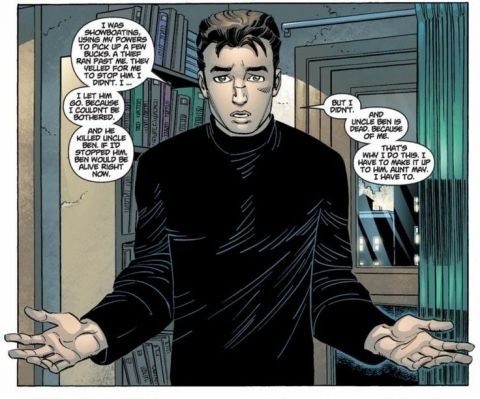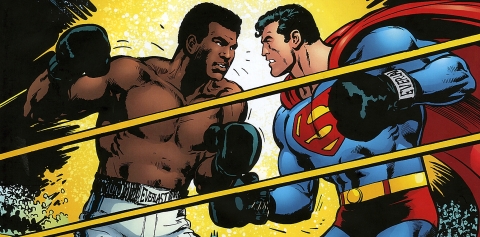52 weeks. 52 different writers. 2 trade paperbacks or hardcovers a week. Each week I’ll take a look at a different writer and read two different collected editions from within that person’s repertoire to help in the examination of their work. Brian Michael Bendis is in the spotlight this week as we take a look at some of his creator owned and work for hire pieces. Oh hey, we also made it through a full month of this challenge now and my girlfriend hasn’t left me yet. That’s good news.
Brian Michael Bendis
For years Bendis has been a staple of the Marvel writers pen. But long before he became one of the biggest writers in comics, Bendis began with a few titles over at Image Comics. Powers was one of those comics, teaming up with Mike Oeming to tell a noir superhero story and helping to produce some of his best work within that sub genre. In 2001 Bendis was nominated for an Eisner award for Best Writer for his work on Powers, Fortune Glory and Ultimate Spider-Man, going on to actually win the award in 2002 and 2003 for his work on several books. Powers would also win an Eisner in 2001 for Best New Series.
Powers Vol 1: Who Killed Retro Girl
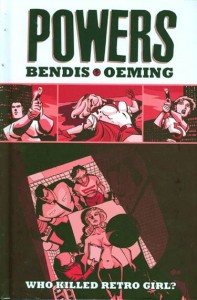 Powers is a story all about homicide detectives that are responsible for dealing with crimes involving super powers. Powers follows Detectives Christian Walker and Deena Pilgrim as they begin their partnership while trying to uncover who killed the American icon, Retro Girl. As the road winds down to find Retro Girl’s killer, a personal stake in the case is revealed for Detective Walker.
Powers is a story all about homicide detectives that are responsible for dealing with crimes involving super powers. Powers follows Detectives Christian Walker and Deena Pilgrim as they begin their partnership while trying to uncover who killed the American icon, Retro Girl. As the road winds down to find Retro Girl’s killer, a personal stake in the case is revealed for Detective Walker.
Powers has a slow build nature that peaks late in the final chapter. It’s an unconventional style of story, melding together crime-noir with superheroes, existing in a weird sub-genre of crime fiction. Being exposed to a new style of storytelling with a rich type of fiction is one of the most enthralling parts of the entire volume. From the early moments Bendis establishes a tone that he holds strong throughout the entire story as there’s a true grit to this volume that feels just as much like a procedural television show as it does a superhero book.
In terms of characters, the focal point of the entire story is split between Retro Girl as well as the partnership between Christian Walker and Deena Pilgrim. Beyond that everyone from Calista, an orphaned child that Christian takes in following a case, to Christian’s ex-partner play a factor on the story in some capacity. Even though Retro Girl has no lines of dialogue at all, her personality and character shines through in spades because of Bendis’ style of writing. One of the best moments used to describe Retro Girl is when a series of characters are interviewed following her passing and they all recollect how she saved these people or how she impacted their lives. It is a moment that uses a clever storytelling mechanic to inform us of a character who hardly gets any panel time. Any other writer could have just left us with the fact that Retro Girl was killed but Bendis takes it a step further, humanizing and idolizing her at the same time.
As mentioned above, the partnership that develops between Walker and Pilgrim is another important factor in the story. It is a classic mixture of two vastly different characters to provide interesting moments. Christian Walker is a long time veteran when it comes to dealing with the “powers” and has a few skeletons in his closet. He has a physically intimidating appearance but is still soft spoken. You can see that years of working this job have done a number on him but he’s still committed to seeing cases through. Deena Pilgrim is as quick as a whip and sharp as a razor, making her someone capable of not only keeping up with Walker but at times challenging him. She requests to be his partner because of her desire to be out on the streets dealing with the “powered” crimes and as such she only wants to work with Walker. The two distinct personalities clash and mesh at the same time, working to balance each other out in the best and worst of ways.
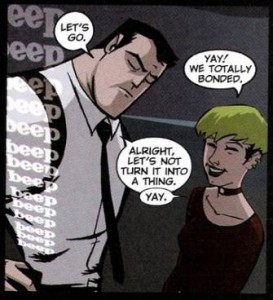
As far as dialogue goes for Powers, it’s a bit of a frustrating read at times. Bendis chooses to use a writing technique that showcases interruption in someone’s speech pattern but uses it so much that you feel like every single character has a stutter. An example of this technique is someone will speak like “So I–I just walked–walked over to–to–say hi and–and they didn’t say it back at all!”. It is something that would be perfectly acceptable maybe once or twice an issue but Bendis seems to employ it multiple times in every issue with seemingly every character, resulting in dialogue that makes you want to rip your eyes out at times. Furthermore, Bendis has a habit of having characters ask a question, then having another character state the question just asked to then have the character who asked the question in the first place ask it yet again. It is lazy to see a conversation go something like: “The guy jumped?” “The guy jumped.” “The guy jumped out the window?” “Oi.” – It is simply a waste of page space to do something like this and it is a tool Bendis yet again uses until it crashes into the ground.
Another downfall to the first volume of Powers is the conclusion but upon further review you realize that the pacing of the comic is what actually hurts the conclusion. To put it blankly, the conclusion for a story that has that murder mystery/noir crime feel shouldn’t be even half as underwhelming as the conclusion to who killed Retro Girl. It feels rushed, like the killer suddenly pops up on Walker and Deena’s lap to conveniently tie the whole story together and move on to the next arc. Looking back further you can see that it really shouldn’t be a surprise that the conclusion is rushed because they never really develop many clues as to who the killer is in the first place. A minor clue gives way to introduce an important character to the story and a simple few words serve to be the only clue really needed in catching the killer. As far as things go in terms of a mystery, there really isn’t one as there is no sense of urgency nor drama for the reader to draw from. Instead of fearing for when the killer will slip the knife in for the next fatal blow you’re left wanting to anticipate some hint at who the killer is but you never really get it. Again, there are a few clues but the “villain” is so paper thin that it unravels the whole mystery when they are revealed. Ultimately the crime feels just as hollow as the reveal does as you’re left wondering “what’s the point?”. Things just don’t add up by the end of the volume and that is thoroughly underwhelming.
Just because this noir superhero piece fails to be a true mystery isn’t a reason to avoid this volume. One should absolutely read this because again, it adds a new layer to the fiction of comics by showing this genre done well in terms of its style. What makes this volume of Powers great is the fact that it constructs this new world for the reader to play in. To take it a step even further, in the hardcover collection there is practically two issues worth of extra content as you see everything from the first script of Powers issue one to the anatomy of a cover, character sketches and even the comic strip format that was released to help promote Powers in the first place. It is great incentive for people who are already fans of the series but even greater incentive for someone who is looking for a good bang for their buck.

Best Character: Retro Girl
Best Line Of Dialogue/Caption: “Damn sucky cartoons.” – Calista
Best Moment/Scene: Walker tries to negotiate with a man holding a seven year old girl hostage.
Best Issue: Issue 2. This issue is where we have two different stories running in tandem on the same page as you watch Walker and Pilgrim try to solve who killed Retro Girl while along the bottom of the page a newscast plays informing you about the public opinion of Retro Girl. It is a brilliant bit of magic on Bendis’ part that feels so natural and obvious when you see it but it is something that not many writers would have even thought to pull off. You genuinely feel like you’re watching this news report as with every turn of the page you see something new develop.
Why You Should Read It: Powers is important to read because it establishes the bar for noir crime superhero stories. The character work is top notch as you get a new layer for charaters like Walker the further you get in the story. Retro Girl has no lines of dialogue but by the end of the story you feel like you know her as well as any other character on the page. Powers isn’t a good murder mystery story but it is a great character driven story instead.
Ultimate Spider-Man Vol 1: Power And Responsibility
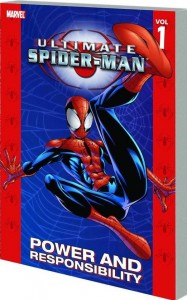 There is no denying that Ultimate Spider-Man #1 is the single most important book of Brian Michael Bendis’ career. Not only did Bendis help elevate the status of the Ultimate publishing line with it, he defined a whole new Spider-man for a new generation of readers. It is about as great a depiction of a teenage superhero you’ll find for the modern era, combining the melodrama of high school with the struggles of having super powers. Fast forward a decade and Bendis is still the only person to have ever written the Ultimate Spider-Man ongoing series and has even gone as far as introducing a new African American Spider-Man, Miles Morales, in place of Peter Parker. Think about that for a second, how many modern comic writers can say they have been writing a book or character uninterrupted for over a decade at Marvel or DC? Not many.
There is no denying that Ultimate Spider-Man #1 is the single most important book of Brian Michael Bendis’ career. Not only did Bendis help elevate the status of the Ultimate publishing line with it, he defined a whole new Spider-man for a new generation of readers. It is about as great a depiction of a teenage superhero you’ll find for the modern era, combining the melodrama of high school with the struggles of having super powers. Fast forward a decade and Bendis is still the only person to have ever written the Ultimate Spider-Man ongoing series and has even gone as far as introducing a new African American Spider-Man, Miles Morales, in place of Peter Parker. Think about that for a second, how many modern comic writers can say they have been writing a book or character uninterrupted for over a decade at Marvel or DC? Not many.
In the classic Spider-Man tradition, Ultimate Spider-Man follows the struggles of a teenage Peter Parker coming into his own as a superhero. Ultimate Spider-Man takes the origin story that everyone knows and loves, expanding it into a seven issue arc that sees the defining moments in Spider-Man’s career, the development of his relationship with Mary Jane, the introduction of much of his secondary cast as well as his greatest villain, the Green Goblin. Following the spider bite that grants him powers, we see Peter go through some growing pains as he struggles to find balance between dealing with the bullying he’s always faced and getting revenge against said bullies.
The story you get from this first volume of Ultimate Spider-Man is well balanced, hitting all the key notes for a satisfying origin story. You get the moment Peter was bite by the spider, the joy of having the powers, the corruption that comes with absolute power and the the fateful discovery that sets Peter straight and defines why he fights the good fight. There are so many different scenes crammed into these seven issues that it is hard to keep track of them all, with there being far more forgettable scenes than memorable ones simply due to sheer volume. In the first issue there is a new scene beginning almost every two pages and when you consider that the first issue is already an over-sized issue to begin with you then realize that that is quite a few transitions. Although this collection houses seven issues to tell the origin story, I’d say that it is really the first five issues that tell the true origin with the final two issues in the volume being used to have Peter face off against his first great threat. Each of these first five issues seem to embody a classic moment from Spider-Man’s origin that allows the story to be stretched to the length that it is. It is wise on Bendis’ behalf to slowly build up the character of Peter Parker and his powers, choosing to not overload the character with everything all at once.
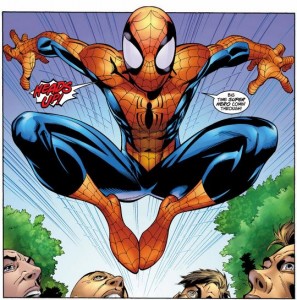 One of the strongest aspects of this story is Bendis’ dialogue and how he perfectly summarizes the daily struggle of a teenager. The dialogue here is simply some of the best Bendis has used in his career, largely due to the fact that it feels so natural. The characters and the way they speak doesn’t feel like it was written by Bendis, it just feels like these characters are actually talking. There isn’t the excessive use of the words “Yo” or “dude” because that isn’t the way that teenagers always talk and using dialogue like that tends to feel corny and unnatural. In having the characters speak the way they do, Bendis succeeds into tapping into the personality of many of these teenage characters. Bendis also does a tremendous job of playing up the teenage melodrama. Small incidents feel like the end of the world to these characters, making some of them feel like it is even them vs. the rest of the world, even though in five years these characters would look back and laugh at these times. It is like an odd glimpse into a mirror in some ways, as you’re sure to see at least one character that reminds you of your time in high school.
One of the strongest aspects of this story is Bendis’ dialogue and how he perfectly summarizes the daily struggle of a teenager. The dialogue here is simply some of the best Bendis has used in his career, largely due to the fact that it feels so natural. The characters and the way they speak doesn’t feel like it was written by Bendis, it just feels like these characters are actually talking. There isn’t the excessive use of the words “Yo” or “dude” because that isn’t the way that teenagers always talk and using dialogue like that tends to feel corny and unnatural. In having the characters speak the way they do, Bendis succeeds into tapping into the personality of many of these teenage characters. Bendis also does a tremendous job of playing up the teenage melodrama. Small incidents feel like the end of the world to these characters, making some of them feel like it is even them vs. the rest of the world, even though in five years these characters would look back and laugh at these times. It is like an odd glimpse into a mirror in some ways, as you’re sure to see at least one character that reminds you of your time in high school.
Speaking of these characters and how you relate to them, Bendis does an excellent job of covering all the different stereotypes of teenagers. From your nerds, to your jocks, to your goths (eventually) they are all there. There’s a plethora of characters in this story as you’re introduced to Peter Parker, most of his secondary cast and even a few characters that will become villains down the road. Bendis writes each character in a way that differentiates them all from one another. No two characters are even remotely identical, with Bendis going to great lengths to make sure even their speech patterns are different. Peter Parker is a great blend of quips, wit and charm here just as we know the character to be. From every cast member you get something new and different whilst also getting the essence of who these characters are in relation to Spider-Man history. Mary Jane is still quite the looker as she’s also been known for but Bendis decides to play up her brains here, giving the character far more depth than being “just a model” or Peter Parker’s soulmate. Similarly someone like Aunt May, who is typical portrayed as frail or dainty, is a tough older woman who’s character only grows stronger with time. In light of her tragic loss of Uncle Ben, Aunt May starts to become a character who takes a no nonsense approach and truly blossoms into her own as a unique depiction from the character everyone knows her counterpart to be. This is a change that happens over the decade plus run of this book but it is all kick started right in these very pages.
Collects: Issues 1-7 of “Ultimate Spider-Man”
Best Character: Peter Parker
Best Line(s) of Dialogue/ Caption: “It’s all so clear now, Uncle Ben. It’s like I’ve been wearing a blindfold and earmuffs all my life–and someone just ripped them off me. I see the world clearly now–and I see what my place is in it.” – Peter Parker
Best Scene/ Moment: Peter Park gets his web shooters – Issue 6
Best Issue: Issue 5 – Life Lessons. Issue 5 seems to run far too short. You feel like after you turn your first page you’re already hitting the final page. This issue deals head on with the moment that forever sculpts who Peter Parker becomes as Spider-Man. It is emotional, strong and brilliant for a coming of age comic. It is the moment from Peter’s history that everyone knows but isn’t any less powerful in its execution.
Why You Should Read It: Read this for the fun dialogue, great stories or believable characters. You can take your pick really because this is a book that has so much going for it. If you’re a Spider-Man fan and have never read Bendis’ time with his Ultimate counterpart it is something you should do with haste. This book kicks off over a decades worth of Spidey stories from Bendis and company that have brought a whole new level to the character. Ultimate Spider-Man is equally comedic and heart warming as it is gut wrenching at times, serving itself up to be one of the most culturally significant comics of the last twenty years.


